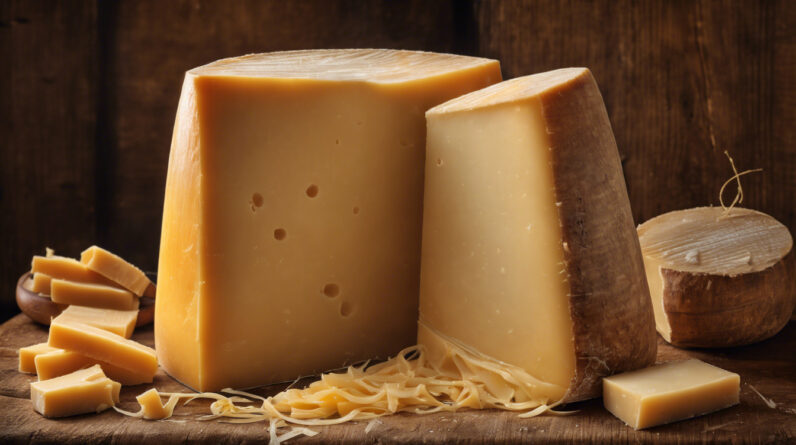Springtime in Italy is synonymous with the emergence of fresh, tender spears of asparagus, poking through the soil ready to be snapped up and savored in a multitude of dishes. This verdant vegetable has long been celebrated throughout Italian cuisine, not just for its delicate flavor, but as a harbinger of the new season—un tempo nuovo.
Did you know? Asparagus has been gracing Italian plates since ancient Roman times. They even had a saying, “Velocius quam asparagi conquantur”, meaning “Faster than cooking asparagus,” for something incredibly quick—because that’s just how speedy it is to prepare this vegetable to perfection!
If you’re looking to dive into this crispy, crunchy delight, here are some foodie-approved Italian classics that highlight asparagus:
- Risotto agli asparagi – a creamy, dreamy risotto that allows asparagus to shine against the rich backdrop of Arborio rice and Parmesan cheese. It’s a dish that is simple yet luxurious, and utterly Italian in every spoonful.
- Frittata di asparagi – imagine fresh asparagus enveloped in a fluffy, golden cloud of eggs, with a touch of pecorino cheese. It’s a rustic, hearty slice of Italian countryside that will have you craving seconds.
- Pasta primavera – the name says it all. “Springtime pasta” is a playful mix of asparagus with other spring veggies, all tossed with al dente pasta in a light olive oil or butter sauce. It’s like a spring garden in your mouth!
These are just a sample of the many ways asparagus is featured in Italian cooking. But let’s get into the culture a bit, shall we? In Italy, asparagus picking is more than just harvesting vegetables; it’s more of a social ritual. Families and friends often head out together to hunt for the wild asparagus that grows in the countryside. Once the bounty is collected, it’s back home to cook up a storm—talking, laughing, and of course, sipping on some Prosecco.
Remember, Italians are masters at not overcomplicating things. The key to their asparagus dishes is to keep them simple, letting the fresh flavors take center stage. A little bit of olive oil, a sprinkle of salt, and you’re in business—a lesson in cooking that extends beyond the borders of Italy. So, next time you have your hands on some fresh asparagus, think less fuss, more flavor, and create a springtime Italian feast that pays homage to this magnificent vegetable.
“To eat well in Italy is to understand the nuances of each region’s dishes—the subtle dance of flavor that can turn simple asparagus into a culinary masterpiece.”
Before we wrap up this love letter to asparagus, let’s talk about the quintessential Italian approach to eating: it’s not just a meal, it’s an experience. The slow, deliberate savoring of each dish, the joy in the fresh ingredients, and the resulting lively conversation around the dinner table (or ristorante) really encapsulate the spirit of Italian dining.
So while the crisp snap of asparagus might echo the emergence of spring, it also signals the Italian philosophy of slowing down, enjoying the season, and basking in the simple pleasures of life. Buon appetito!
Summer’s bounty: Zucchini-centric Italian recipes
As the sweltering summer sun bathes Italy’s rolling hills and bustling cities alike, the markets burst with the bounty of the season. Amongst the luscious produce, zucchini takes center stage. This versatile vegetable transforms into mouth-watering dishes that are central to Italy’s summer cuisine, where the zucchini is not merely an ingredient—it’s the star!
Now, let’s whisk ourselves away to a little Italian kitchen where zucchini reigns supreme. One classic dish that encapsulates the essence of Italian summers is Zucchini alla scapece. Picture thinly sliced zucchini, fried until just tender and marinated with vinegar, fresh mint, and garlic. This dish sings with bright flavors and is a perfect antipasto to start any meal. Or, if you prefer something to share around the table with gusto, look no further than Zucchini ripieni, zucchini boats stuffed with a tantalizing mix of breadcrumbs, cheese, and herbs, then baked to golden perfection.
Let’s not forget the divine Fiori di zucca, zucchini flowers delicately stuffed with ricotta cheese and anchovies or mozzarella, then lightly battered and fried. These are a sought-after delicacy that showcases the tender beauty of summer in every crunchy, gooey bite—truly a work of culinary art.
“In the hands of a true Italian cook, a simple zucchini can be transformed into a dish that rivals even the most intricate of creations—simplicity and elegance on a plate!”
When you dive into these dishes, you’ll not only taste but also feel the sun-drenched Italian summer. Imagine eating al fresco, a table filled with family or friends, a carafe of chilled white wine, and a parade of zucchini dishes; this is Italian summer eating at its finest.
As you savor every bite, remember the cultural nuances at play. Lunches stretch lazily into the afternoon, with each dish shared and enjoyed at a leisurely pace. Italians have an endearing term for this: dolce far niente, the sweetness of doing nothing. The food tastes all the sweeter because it is meant to be a break from the hustle of daily life, a moment to revel in the joys of good company and great food.
In the world of Italian cuisine, zucchini is not just an ingredient—it’s a reason to gather, to cook, to eat, and to celebrate the sweet, simple pleasures that summer brings. And as the zucchini flowers bloom and the vegetable finds its way into kitchens across Italy, we’re reminded that sometimes, the simplest things can bring the most joy. So whether you’re dining in Italy or bringing a little piece of Italian summer into your own home, let zucchini be your guide to indulging in the season’s gifts.
End your summer dinner on a light yet satisfying note with a simple insalata: ribbon thin slices of zucchini, a drizzle of extra virgin olive oil, a squeeze of lemon, and a sprinkle of sea salt. This dish is as easy as it is refreshing—a true testament to the Italian way of not complicating the fresh flavors of the season. And, of course, always remember the Italian philosophy: la vita è troppo breve per mangiare male—life is too short to eat poorly. Buon appetito!
Risottos and pastas: Integrating seasonal greens

Now, we wander into the realm of Italian comfort food where comforting risottos and robust pastas meet the vibrant hues and flavors of freshly picked greens. There’s something about stirring a creamy risotto that feels like a warm embrace, and the Italians know this culinary embrace all too well. Picture a pot of Risotto verde, its naturally creamy texture a result of the Arborio rice slowly imbibing a savory broth, and then enhanced with the bright notes of seasonal asparagus or zucchini simmered to al dente perfection.
The beauty of Italian risotto is its versatility—you can mold it to fit the ingredients of any season. But it’s during the spring and summer months, with the abundance of vegetables like asparagus or zucchini, that the risotto truly achieves a seasonal resonance. Each grain of rice holds within it the essence of these greens, and it’s this simple yet profound integration that can transport you straight to a cozy trattoria tucked away in the countryside.
And let’s not overlook the pastas. In a country that venerates its pasta almost religiously, fresh vegetables like asparagus and zucchini are the perfect companions to turn an ordinary plate of pasta into a lively celebration of the season. Take, for instance, the Penne with zucchini and ricotta; it’s a light, yet utterly satisfying dish that weaves the creamy ricotta with the slightly caramelized zucchini—a dish that tastes like pure summer sunshine on your palate.
For a more intimate affair with spring flavors, there’s the elegant yet straightforward Tagliatelle with asparagus and lemon. It’s the kind of dish that requires minimal ingredients but delivers an explosion of fresh flavors. Every twirl of pasta is a tribute to the crispness of spring asparagus, brightened with a zest of lemon to elevate the dining experience.
“Italian cuisine has a knack for turning the simplest of ingredients into a symphony of flavors, and there’s no better orchestra than the inclusion of seasonal vegetables in risottos and pastas.”
In the quintessential Italian kitchen, pasta and risotto are more than mere dishes; they are canvases for seasonal ingredients to shine. As you integrate these delightful greens into your culinary repertoire, embrace the pause that comes with crafting each dish. It’s this rhythm, the slowing down and savoring of both the process and the resulting meal, that embodies the spirit of Italian cooking.
And when you do sit down to feast, be it with a hearty riso or a lively pasta, remember that in Italy, food is about more than sustenance. It’s about tradition and storytelling around the table. It’s a moment where food intertwines with friendship, family, and the art of living a life flavored generously with joy and, most importantly, with love.
So whip out your favorite pot, cook up some seasonal greens with your pasta or risotto, and open your home to the Italian way of life, where every bite tells a story, and every dish is an expression of the season’s best. In the words of countless Italian chefs and home cooks alike, il segreto è nella semplicità—the secret lies in simplicity.
Italian soups and stews with a vegetable twist
As the leaves start to turn and the air gets crisper, Italian kitchens begin to bubble with the warmth and comfort of soups and stews. When the cooler seasons sweep through, it’s time to celebrate the earthy flavors of asparagus and the versatility of zucchini by weaving them into the rich tapestry of traditional Italian minestre (soups) and stufati (stews).
A bowl of Minestrone primaverile, or spring vegetable soup, is both a feast for the eyes and the palate. Laden with asparagus, peas, and broad beans, this soup captures the essence of spring in Italy. Picture this: a simmering pot on the stove, its aroma filling the kitchen, announcing that a wholesome, comforting meal is on the way. Minestrone celebrates the garden’s yield, with each ladleful offering a delicate marriage of flavors and textures, dancing together in a rich vegetable broth.
Then, as the zucchini flowers bloom, Italians look forward to hearty bowls of Zuppa di zucchine e basilico, zucchini and basil soup, which is simplicity at its finest. The mild flavor of zucchini is elevated with the sweet and peppery notes of fresh basil, and often a generous sprinkle of grated Parmigiano-Reggiano to finish. This soup doesn’t just warm your body; it warms your soul and is often enjoyed with a side of crusty bread, perfect for sopping up every last drop from the bowl.
Let’s not forget the robust, heartier stews which often take center stage during family gatherings. A good stufato di verdure, or vegetable stew, with tender chunks of zucchini and asparagus, simmered with tomatoes and herbs, serves as a testament to the Italian way of slow cooking. The stew cooks patiently, allowing the individual flavors to meld and intensify over time.
“The Italian kitchen is heartwarming, where stews simmer to perfection and soups are ladled with love, all while engaging in the beauty of shared stories and laughter that echo through the household.”
As you enjoy these soups and stews, remember the important cultural norms that come with dining in Italy. The meal is meant to be savored without rush, often accompanied by animated conversation. It’s a chance to gather and appreciate the warmth of good company and the comfort of a home-cooked meal. The vegetables within each dish are more than just ingredients—they carry the story of the season and the land from which they came, imbued with the love of the hands that prepared them.
In an Italian kitchen, the making of soup or stew is a ritual that celebrates the humility of home cooking, the beauty of seasonal produce, and the nurturing of both body and spirit. Whether a light and bright spring minestrone or a hearty autumn stew, each dish provides a nurturing way to embrace the change of seasons—Italian style.
So, pull up a chair, cradle your bowl of vegetable-laden goodness in your hands, and let the magic of these Italian soups and stews envelop you. The time-honored traditions, the respect for simple, fresh ingredients, and the joyous act of sharing food are all encapsulated in these deceptively simple dishes. And, true to the Italian spirit, let each spoonful remind you that the heart of Italian cooking lies in its celebration of the gifts of the earth and the company with whom you share your meal.
Light and fresh: Salads showcasing asparagus and zucchini

Now let’s indulge in the lighter fare of Italian cuisine—where salads are not just a side dish but a showcase for the fresh, vibrant flavors of seasonal vegetables like asparagus and zucchini. Italians have an artistry about them, turning something as humble as a salad into a beautiful centerpiece that delights both the eyes and the palate. For them, salads embody the joys of the garden and the creativity that can flourish within the bounds of simplicity.
Take, for example, the Insalata di asparagi e pecorino, a stunning asparagus salad that pairs the snap of just-blistered spears with the bold sharpness of pecorino cheese. It’s a textural dance, where thin shavings of cheese meet the crunch of asparagus, all brought together with a twist of black pepper and a drizzle of high-quality extra virgin olive oil.
Then there’s the zucchini’s moment to shine, in the delightfully simple, yet utterly refreshing, Carpaccio di zucchine. Imagine paper-thin slices of raw zucchini, fanned out on a plate like petals of a flower, then adorned with a sprinkle of sea salt, a generous squeeze of fresh lemon juice, and a scatter of toasted pine nuts for a touch of warmth and crunch. This dish is summer on a plate—a gentle reminder of Italian fields basking in the golden sun.
“A true celebration of the Italian summer, salad dishes are an invitation to taste, to enjoy, and to linger over the fresh bounty that nature provides.”
In the dance of salad making, no two performances are the same. Each is a unique creation, celebrating the season’s best. Picture the Insalata di asparagi, rucola e parmigiano, a vibrant mingling of asparagus with peppery arugula and shards of Parmigiano-Reggiano—the result is nothing short of a springtime aria, with each flavor harmonizing in delicious melody.
Among the Italian food traditions, there is also room for playful experimentation, and salads are the perfect canvas. Imagine adding a twist to the classic caprese with thin ribbons of zucchini, or tossing asparagus tips with farro or quinoa for a heartier yet equally fresh dish. Each combination is not just a recipe, but a story of the land, the weather, and the cook’s ingenuity.
Salads featuring asparagus and zucchini are also reflective of important cultural norms in Italy—where meals are a time for relaxation and pleasure. There’s no rushing through a meal; instead, each bite of salad is savored, each burst of crispy, garden-fresh goodness is enjoyed in the leisurely Italian way. And perhaps, if you listen closely, you’ll hear the sigh of dolce far niente—the sweetness of doing nothing but cherishing the moment and the meal before you.
So as we sit at this metaphoric Italian table, let’s not just eat but relish these light and fresh salads. Let’s appreciate the beauty of asparagus and zucchini, the way they can transform a dish, and the joy they bring to palates all over, as they have for generations in Italy. In this respect, the salads are more than mere food—they are an enduring tribute to the Italian way of life, where food is savored, seasons are celebrated, and every meal is an opportunity to bring a little more beauty and flavor into our lives. Buon appetito!










